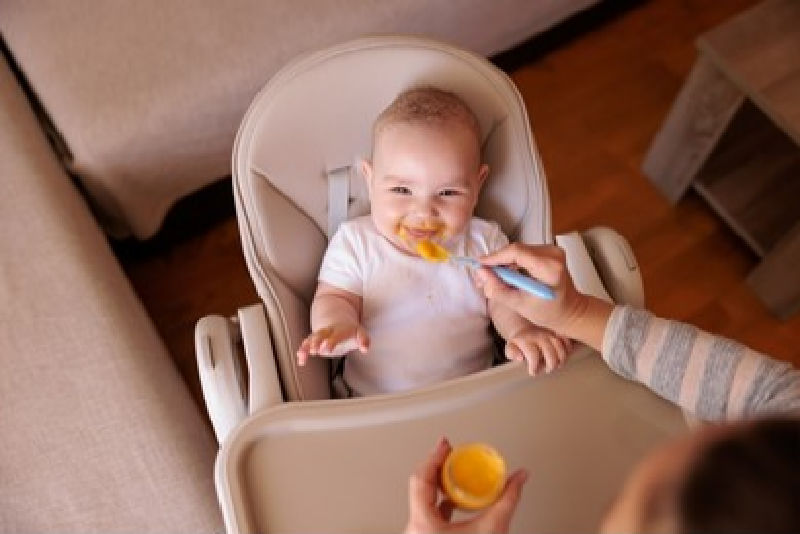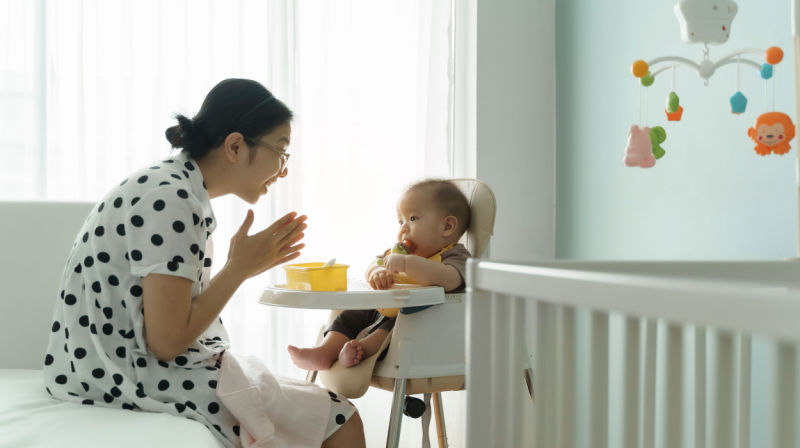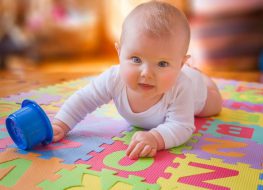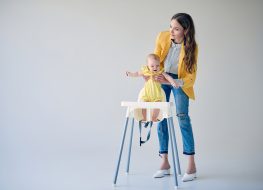
Our babies grow up so fast. One day they’re sleeping soundly beside us without a single shudder; the next, they’re on the dining table with us, sitting on a high chair for babies and eating the same food.
One of the first stages of their development is learning how to eat, so it’s best we get them the right tools or, more specifically, the right seat. Here are a few pointers on what makes the best high chair for babies.
What Are High Chairs for Babies?
Sometimes, when we humor them, we tell our babies that the seat they sit in is called the ‘big kid chair.’ But in reality, we know this particular seat as just a ‘high chair.’
High chairs are the chairs we seat our babies in when we feed them, so they’re not too far from us when we’re at the table. Usually, the small chair with long legs has its own table.
High chairs typically stand around 3 feet high or table height. It can come with straps designed so your baby cannot easily slip out by ensuring the distance between the high chair seat and its built-in table is not wide enough for an older baby or toddler to slip out of without the parents knowing.
What Are High Chairs Used For?
When you teach your baby how to eat, you don’t do it on regular dining chairs. You teach them using chairs designed for them: a baby high chair. Since most dining chairs are designed for pre-teens and older, parents need high chairs for babies to wean them, the period of introducing your baby to eating solids.
Since baby weaning can keep your hands full, a baby high chair might help out. Baby high chairs are designed with height adjustments to make mealtime and clean-up easier for parents. Some manufacturers even make baby high chairs with adjustable height just for this reason.
Different Types of High Chairs
Now, not all high chairs are made equal—all were made with a purpose in mind. Here are three types of high chairs for babies that you should be on the lookout for.
Space Saver
A space saver is a small version of a high chair. Instead of long legs under the small seat, you get a small seat boosted up by just a foot or less. It comes out small at first, but once you place it on a regular dining chair, it becomes its own type of baby high chair, just lacking a table.
Given the name, space savers are usually purchased by parents with little space to spare in their homes and are looking for a high chair for small spaces.
Portable High Chair
Some parents prefer smaller, portable high chairs to regular ones or even space savers like toddler boosters. Some want portable high chairs with wheels on them or one that folds flat.
Portable high chairs give parents freedom along with their baby to eat wherever they want, making dinnertime one simple fold high chair away to convenience. You can even take it to grandma’s house!
Regular High Chair
The regular high chair or toddler chair is the most in-demand on the market. It’s the most common and the most versatile. Normal suburban kitchens have a regular high chair ready in case there’s a baby in need, regardless if it’s theirs or another family.
A regular high chair is also the best affordable high chair because of its simplicity, reducing the cost in manufacturing, materials, and features. However, regular high chairs aren’t known to be the sturdiest or the flashiest. So if you’re planning on getting one, be sure to manage expectations.
Booster Seat
A booster seat is similar to a space saver because it is smaller and easier to store at home. However, unlike the space saver, the booster seat is loaded with many different features, making it one of the best baby gear on the market. You can put it into high chair mode or any mode you want.
A booster seat can have a padded seat, seat cover, adjustable footrest, and recline positions. It can also have its own tray positions and can become stain resistant, depending on the seat fabric you plan to customize it with.

Best Materials for a High Chair
Now, the best high chair for babies, regardless of what type, can’t be the best on the market without the right materials. Here are three of the market’s most used materials for baby high chairs.
Plastic
There is an abundance of plastic high chairs on the market, and for a good reason. Compared to the other materials, plastic is the easiest to make high chairs with.
They are the most affordable and flexible, making composition and design much easier. Since they are also lightweight, plastic high chairs are also easier to bring when traveling or relocating to a different home—perfect for parents on the go. Plastic is also easier to clean compared to wood and steel, and its flexibility leaves very little room for it to fracture.
The bad side is plastic high chairs are the least durable and, due to the texture and shine of plastic, often the tackiest. In addition to breaking the easiest, some plastic high chairs are also manufactured with harmful chemicals, making them dangerous to a baby’s overall health and well-being.
Wood
It’s safe to say that wood is the best material to make baby chairs with. Parents report wood as the most beautiful material to place around their home, not to mention the sturdiest. A high chair made from high-quality wood can give you years of use in the home.
However, wood isn’t exactly the most affordable high chair. A baby high chair made of wood can cost you a hefty sum. It will also hurt a lot more if you’re not careful since wood is harder to clean than plastic or steel.
So if you’re considering getting a wooden chair, make sure you take maintenance into account, too.
Metal
In addition to being stylish, metal high chairs are also some of the sturdiest and long-lasting high chairs on the market. Metallic surfaces also make it easy to clean—simply wipe it down with a clean cloth and pat it dry then you’re done.
However, like wood, metal high chairs are more expensive, and the more affordable options could be made of lesser quality metal, making it a danger to your child.
How to Clean High Chairs for Babies
Many parents know that feeding time can get really messy, so maintaining your high chair should be at the top of your list of priorities. Not maintaining your high chair could lessen its sturdiness in the long run or, worse—leave your baby exposed to harmful germs and bacteria.
Here are some tips on cleaning your high chair, divided into after each use, weekly, and monthly.
After Use
Every after-mealtime is when your high chair is the messiest, at least on the outside. Food stains and crumbs will litter your toddler table, and it can feel impossible to clean for a while.
But after-use cleaning can be simple. Start by brushing dry crumbs off the surface of your toddler table and seat cushion. Afterward, you can wipe down both the table and seat cushion with a damp cloth, removing any wet stains or excess dirt. Ensure you also disinfect the high chair table so your baby eats safely every meal.
Weekly
While you have to clean your high chair daily, you must also take time every week to do more thorough maintenance. After post-meal cleaning, wipe your high chair’s legs and undersides, too. Be careful, though. Don’t use bleach for wood or fabrics, and don’t soak the metal parts in water since they could rust and fall apart.
Note: if you’re using a space saver, make sure you clean under the high chair, too, since crumbs could make their way into the small spaces.
Monthly
Here’s where the heavy lifting comes in. Since you clean the outside on a daily basis, you should set aside some time to take the high chair apart and clean it then.
Remove and wash the straps and seat cover (some chairs come with a three point harness or five point harness—remove those, too) and brush the crevices between the straps and chair parts for leftover crumbs. Use a brush when cleaning the small spaces so you get to wipe off every speck.
You should also remove the adjustable dishwasher-safe tray, tray clips, and adjustable seat (if plastic, wash thoroughly in a separate area and dry them) and wipe them down separately. Brush the spaces in between for dirt.
When the straps, seat pad, and seat cover have dried off, you can put your sturdy high chair together and feed your baby again!
When Will You Need a High Chair for Babies?
You’ll need a high chair as soon as your baby is ready to eat solid foods, which is around four to six months old. Four to six months old is the average age a baby can start eating solid foods, so it can differ from child to child.

Ashtonbee’s Wooden High Chair for Babies and Toddlers
If you’re in the market for a high chair, then you should check out Ashtonbee’s Wooden High Chair for Babies and Toddlers—the best wooden high chair for younger babies and toddlers! With its modern design, our high chair is a must-have for the dining room.
We design our chairs from Beech tree wood and food-grade polypropylene, ensuring the safest, sturdiest option for your baby’s mealtime. Also, unlike the traditional high chair, our high chair comes with an adjustable footrest under the toddler seat, giving your baby more room for his feet as he grows!
Ashtonbee’s high chairs are built to last, so grab one now to make baby’s mealtime extra easy!



